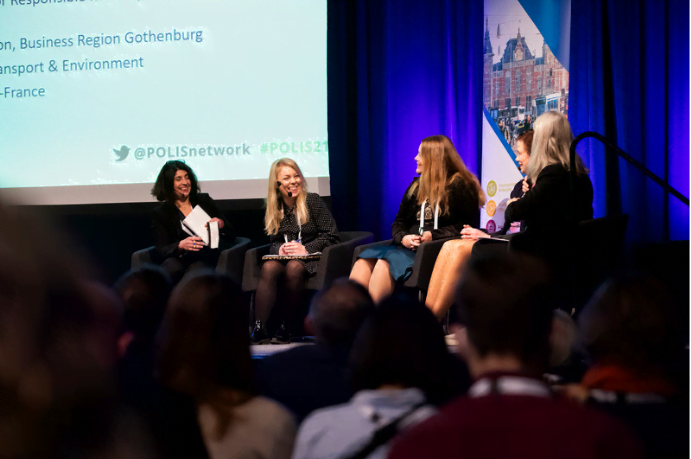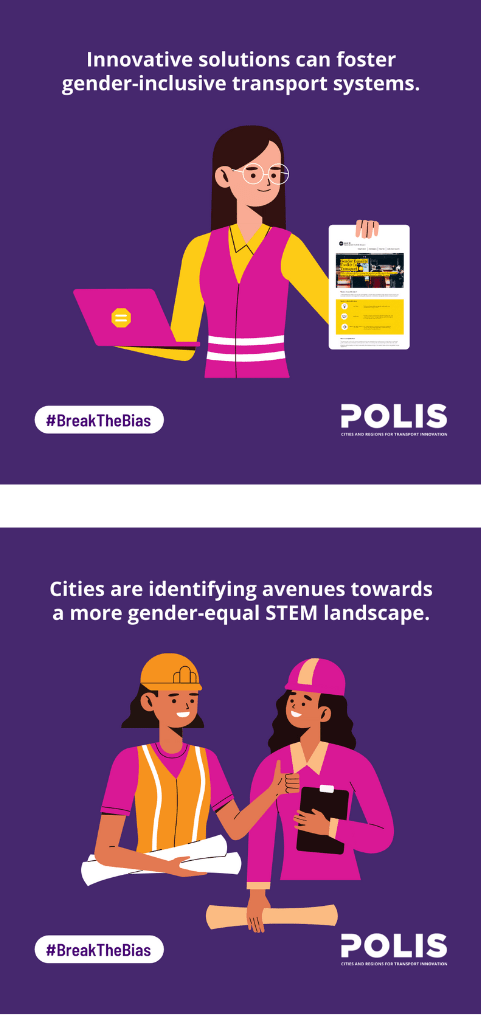Women on the move
The transport sector urgently needs to address its gender (in)balance. But what does parity look like on the ground, and how do we get there?
Women account for just 22% of Europe’s transport workforce. As immediate fuel concerns, carbon neutrality goals, and accessibility issues collide, mobility finds itself at a crucial juncture, where gender-equal employment is no longer simply a human rights issue, or an ‘added benefit’, but a necessity for the sector’s prosperity.
From freight to aviation, rail to maritime, and the automotive sector, each mode faces unique challenges for creating gender equal employment. However, there are many shared issues, and progress requires international, cross-sector action, building on others’ successful initiatives, learning from failures, and recognising potential for advancement.
To support both public and private stakeholders on this journey, POLIS – with funding from the FIA Foundation, is producing a practical guide to and toolkit for the essential changes which need to be made to secure greater female participation in the sector based on good-practice examples.

SUM4All is funded by FIA Foundation. Credit: SUM4All
The research, being conducted as part of POLIS’ membership of the SUM4All Gender Working Group, will form a very practical support tool for national and regional policymakers, regulators and other key planners and decision-makers in the field.
‘FIA Foundation is delighted to be supporting this work. Supporting women who are frequently in the minority as workers in the transport sector, is a vital aspect in ensuring a gender-balanced approach to sustainable mobility,’ says Sheila Watson, Deputy Director of the FIA Foundation.
Where the problems are manmade… the future is feminist!
From the ITF and UITP Positive Employer Gender Policy, to the World Bank’s guidance for the freight industry on gender-equal employment, we are seeing increasing calls for action, and leading transport bodies are placing gender higher on the agenda than ever before.
But what are the primary hurdles, and what does translating ambition into action look like on the ground?
STEMing the gap: Training & Education
Recruitment starts far before the interview room. Setting quotas and conducting ‘gender blind’ interviews will be fruitless if we are unable to create the necessary education and training opportunities required for women to enter the transport sector in the first place. Science, technology, engineering, and math (STEM) must be made more attractive and receptive to female students.
Girls and women are – as the latest UN report asserts, ‘systematically tracked away from science and math’ throughout their education, limiting their access, preparation, and opportunities to enter key mobility fields including data science and engineering. Today, three-quarters of STEM students are men – a ratio translated into our workforce.
Reversing this trend requires cohesive collaboration between operators and education providers such as universities and vocational colleges.
POLIS members are pioneering innovative approaches here. EMT Madrid has partnered with the electricity company Iberdrola and Comillas University, to create a Chair for the promotion of women in STEM vocations; conducting roundtables, organising site visits for students, and publishing key reports.

Women's Employability Conference. Credit: EMT Madrid
‘Greater presence of women in public transport must be achieved through the collaboration of companies, public authorities, academia and society as a whole,’ says EMT Director of Institutional Relations and CSR, Julieta de Micheo.
This is a momentous initiative for Spain, a country expecting 390,000 more STEM positions in the next two years, yet less than 8% of its female university students currently choosing these fields.
At the same time, gendered stereotypes still inhibit women from entering STEM fields and bias recruiters. Michelin, a leading global automobile R&D company, runs anti-stereotype training for new apprentices to encourage students to subvert typecasting and select different career paths.
This focus on STEM is also essential for confronting the gendered impacts of digitalisation and automation. Across the board, between 40 million and 160 million women globally may need to transition between occupations as automation accelerates – a slightly higher proportion than their male counterparts.
Thus, as occupations such as ticket sales are displaced by integrated fare payment systems, stakeholders from across the sector must work together to ensure a smooth transition for women’s employment, enhancing access to technologically focused roles.
Driving change: access to licenses
Driving remains an incredibly unequal profession. Improving women’s access to driving is an essential step for all sectors of the industry - particularly given the current workforce shortage.
According to the latest IRU annual driver shortage survey, up to 425,000 truck driver positions, or 10% of the total, remained unfilled in 2021 and are forecast to jump to 14% by the end of this year.
In the US, Women make up just under 50% of the workforce but only account for less than 3% of truck drivers – with similar figures across Europe. Investing in gender diversity is low-hanging fruit for freight – so low, it is probably more like picking the apples off the ground.
Women account for a minority of drivers across trucking, bus, rail and ride hailing; a phenomenon propelled by restrictive national policies and workplace and social cultures.
In countries such as Belarus, women are prohibited from driving a truck, while in Belize, Dominica, and Nigeria, women cannot work in the transport of goods or people at night.
Change is afoot, bolstered by loosening of restrictive policies and positive action from organisations themselves.
‘Our sector needs to become more attractive to women and we need more women in management; this means adapting our education to attract more female students, recruitment and training processes,’ says Yanying Li, Head of Programmes and Knowledge Management (and Gender Equality Officer), at European Technology Platform ALICE, a network representing members of the logistics industry.
Meanwhile, public transport is also investing in female drivers. Transdev initiated an all-female driving school in Melbourne, aiming to encourage more women to consider careers as bus drivers, pushing towards the goal of 40% female bus drivers by 2030.

The all-female Opening Plenary at the Annual POLIS Conference 2021, featuring Margriet van Schijndel-de Nooij, Maria Strömberg, Barbara Stoll, Françoise Guaspare, and Malin Broqvist Andersson. Credit: Emmy Jonsson
Ride-hailing is also looking to women to fill their capacity gaps. While numbers are often not transparent – and vary considerably by region, according to the ITF’s report 'The Impact of the Future of Work For Women in Public Transport', women make up just 3% of taxi drivers in the UK and 2% in Germany.
As research from Uber shows there are many factors preventing women from entering the sector, with access to driving licenses, safety fears, and lack of training noted.
As a result, we are seeing heavy investments in women’s recruitment by major international operators such as Uber. Just this October, they earmarked 1 million Euros for various initiatives to tackle these barriers.
‘This will include programs to subsidise the cost of PHV licences and access to vehicles, building communities and dedicated forums for women drivers, piloting products which allow women drivers to indicate a preference for picking up women riders, and working closely with strong partners like POLIS,’ says Zuzana Púčiková, Uber Director of EU policy.
It’s tough at the top! The importance of leadership
Diversity must also be reflected at the top; aggregate numbers do not make parity. Men continue to dominate transport’s boardroom, with women making up just 15.5% of ministers with transport portfolios across the 27 EU Member States.
Moreover, men hold 6 out of 8 of the top positions in all four of Europe’s major transport agencies – the European Aviation Safety Agency (EASA), the European Union Agency for the Space Programme (EUSPA), the European Maritime Safety Agency (EMSA), and the European Union Agency for Railways (ERA).
Greater opportunity for professional development is essential; which, as a survey from the European Transport Workers’ Federation (ETF) exposed, this is currently not the case.
This is a challenge Mobility XX is tackling head-on. Guided by a Steering Committee comprised of the most powerful women in transport, Mobility XX calls for stakeholders to pledge to diversify their boards, and commit to increasing the female representation on their organisation’s Executive Leadership by 10%. This includes taking actions such as posting job announcements in an accessible way to attract qualified female candidates and creating a diversity and inclusion officer or champion.
The EU's Ambassadors for #DiversityInTransport network seeks to promote diversity, equality, and inclusion within the EU transport sector, by spotlighting diversity and encouraging others to do the same - 'Equality and diversity are core values of the EU, which I personally support. I welcome everyone to apply and become an EU Ambassador for #DiversityInTransport. Help us changing the transport sector,' Transport Commissioner Adina Vălean told Cities in motion.
Addressing work-life balance
Working cultures, practices, and patterns must be reconsidered and revised if women are to retain their jobs in the sectors and advance their careers.
The struggle to balance childcare and professional work is a leading factor impelling women to leave not just the transport sector – but the wider professional world.
It is little surprise therefore that almost one-third of the female respondents to the ETF survey, did not feel their working environment supported them in doing their job.
Addressing childcare burdens will be decisive. Women continue to shoulder over two-thirds more childcare responsibility than men. According to a poll by Ipsos, nearly half of all women with children at home say they spend more than 5 hours each day in childcare.
This figure has dropped over the last several decades and maternity leave rights and paternity (and shared) leave have improved; nevertheless, childbirth remains a critical juncture where many women are forced to choose between domestic and professional spheres.

Meeting of EMT women workers, International Women's Day. Credit: EMT Madrid
The COVID-19 pandemic exposed this clearly as women’s dual commitments stretched them to breaking point. According to new figures, women’s labour force participation dropped, and 5 million fewer young women will be employed in 2022 compared to 2019.
One in four mothers considered leaving the workforce or downshifting their careers versus one in five fathers, according to research from McKinsey; for those with no children, numbers were almost the same.
Enhancing and reinforcing maternity rights is key. As one recent study of 159 countries finds, female labour force participation is positively correlated with the length of maternity leave.
Since 2016, freight company MAERSK have had a ‘Return to Work’ programme which gives onshore employees the opportunity to work 20% less at full contractual pay within the first year of childbirth or adoption for up to six months after returning to work – providing the flexibility assurance many women lack.
However, transformative change requires legal and financial assistance at the national and international levels. 76 countries do not have paternity leave, and astoundingly, 42 do not prohibit the dismissal of pregnant women – a figure that has risen in the last year.
Revising legal frameworks will provide women with the protection to be more confident in their career choices, while at the same time, not making childbirth and childcare a professional ‘choice’.
Increasing paternity leave, while mandating the availability, affordability, and quality of childcare are good first steps; as little as two weeks of paid paternity leave can increase a mother’s probability of reemployment shortly after childbirth.
The EU is stepping up its efforts here. The Commission has ushered in new flexible working arrangements to encourage a better division of caring responsibilities between women and men. The (now adopted) Directive 2019/1158/EU came into effect in August 2022, applicable to all workers who are parents or carers.
Taking the menopause off pause
Menopause is also a topic which needs to be addressed if we are serious about retention.
The Menopause and the Workplace report by the Fawcett Society and Channel 4, found that 10% had left their job because of symptoms of menopause, with many respondents passing on promotion opportunities or reducing their hours – research corroborated by the ‘Menopause transition: effects on women’s economic participation’.
Policy also has a role to play here. Actions such as requiring employers to have menopause action plans, creating a route into menopause healthcare and to ensuring better GP training are essential.
In the UK, Under the Equality Act 2010, menopause discrimination may be covered under three protected characteristics: age, sex, and disability discrimination; however, there is no legislation specifically relating to menopause.
Some in the sector are taking action. Maritime UK’s ‘Menopause Hub’ provides a forum to share good practices, policies, case studies, and self-care guidance, and on World Menopause Day this year, several organisations published a menopause policy.

Promotional images created by POLIS for International Women's Day 2022.
Credit: POLIS Network
Tackling violence in the workplace
Confronting cultures of harassment and violence in the workplace – from office to train carriage – is also an essential step. We often talk at length about the safety and security of female passengers, but female workers also face similar threats.
'We want our mobility systems to be safe and secure- but this means also making sure our workplaces are too,' says Grace Packard, Voi’s Senior Public Policy Manager UK. Indeed, Voi is currently rolling out a diversity and inclusion program to deliver training managers on bias free recruitment decisions.
The International Labour Organisation (ILO) identifies violence as a leading cause of disruption to women’s careers in transport, calling for clear cross-sector dialogue, consultation, and negotiation. This is apparent in Uber’s research amongst their drivers, where almost 50% of respondents regarded the fear of violence as a deterrent for becoming a driver with the platform.
The 2019 Violence and Harassment Convention (the first-ever international standard on violence and harassment in the world of work) is a strong start. However, with just 19 ratifications, it requires public and private sector stakeholders to build on these legal frameworks to cement action on the ground with clear messaging, reporting mechanisms, and follow-up action.
A gender-equal future?
Advancing gender equal employment demands a combination of policy change and practical action by employers.
Across the last decade, we have witnessed a major step change, but now, we can- and must- go further.
Click here to read the article in its original format.
About the authors
Isobel Duxfield is Communications and Membership Manager at POLIS. She completed her MPhil in Gender Studies at the University of Cambridge where she researched gender and cycling. Isobel manages the SUM4All project and has published academic work on gender and active mobility, and domestic violence prevention.
Disclaimer: A visual used to promote this article utilised a vector made by pikisuperstar on Freepik.
